
Moa are an extinct group of flightless birds formerly endemic to New Zealand. During the Late Pleistocene-Holocene, there were nine species. The two largest species, Dinornis robustus and Dinornis novaezelandiae, reached about 3.6 metres (12 ft) in height with neck outstretched, and weighed about 230 kilograms (510 lb) while the smallest, the bush moa, was around the size of a turkey. Estimates of the moa population when Polynesians settled New Zealand circa 1300 vary between 58,000 and approximately 2.5 million.

The yellow-crowned night heron, is one of two species of night heron in genus Nyctanassa. Unlike the black-crowned night heron, which has a worldwide distribution, the yellow-crowned is restricted to the Americas. It is known as the bihoreau violacé in French and the pedrete corona clara in Spanish.

The little blue heron is a small heron of the genus Egretta. It is a small, darkly colored heron with a two-toned bill. Juveniles are entirely white, bearing resemblance to the snowy egret. During the breeding season, adults develop different coloration on the head, legs, and feet.

The laughing owl, also known as whēkau or the white-faced owl, is an extinct species of owl that was endemic to New Zealand. Plentiful when European settlers arrived in New Zealand, its scientific description was published in 1845, but it was largely or completely extinct by 1914. The species was traditionally considered to belong to the monotypic genus Sceloglaux Kaup, 1848, although recent genetic studies indicate that it belongs with the boobook owls in the genus Ninox.

The Pacific reef heron, also known as the eastern reef heron or eastern reef egret, is a species of heron found throughout southern Asia and Oceania. It occurs in two colour morphs with either slaty grey or pure white plumage. The sexes are similar in appearance.
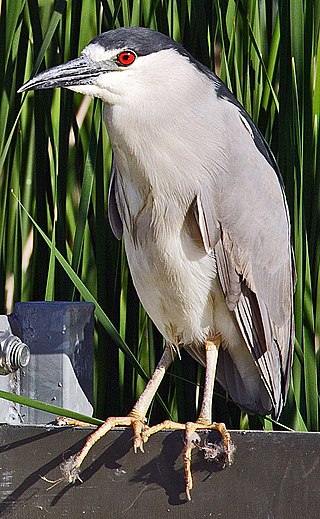
Nycticorax is a genus of night herons. The name Nycticorax means "night raven" and derives from the Ancient Greek νύκτος, nuktos "night" and κοραξ, korax, "raven". It refers to the largely nocturnal feeding habits of this group of birds, and the croaking crow-like call of the best known species, the black-crowned night heron.
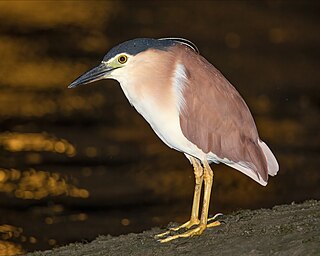
The nankeen night heron is a heron that belongs to the genus Nycticorax and the family Ardeidae. Due to its distinctive reddish-brown colour, it is also commonly referred to as the rufous night heron. It is primarily nocturnal and is observed in a broad range of habitats, including forests, meadows, shores, reefs, marshes, grasslands, and swamps. The species is 55 to 65 cm in length, with rich cinnamon upperparts and white underparts. The nankeen night heron has a stable population size, and is classified as a species of least concern by the International Union for Conservation of Nature (IUCN).
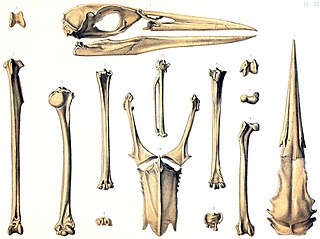
The Rodrigues night heron is an extinct species of heron that was endemic to the Mascarene island of Rodrigues in the Indian Ocean. The species was first mentioned as "bitterns" in two accounts from 1691–1693 and 1725–1726, and these were correlated with subfossil remains found and described in the latter part of the 19th century. The bones showed that the bird was a heron, first named Ardea megacephala in 1873, but moved to the night heron genus Nycticorax in 1879 after more remains were described. The specific name megacephala is Greek for "great-headed". Two related extinct species from the other Mascarene islands have also been identified from accounts and remains: the Mauritius night heron and the Réunion night heron.

Gallirallus is a genus of rails that live in the Australasian-Pacific region. The genus is characterised by an ability to colonise relatively small and isolated islands and thereafter to evolve flightless forms, many of which became extinct following Polynesian settlement.

The Malayan night heron, also known as Malaysian night heron and tiger bittern, is a medium-sized heron. It is distributed in southern and eastern Asia.
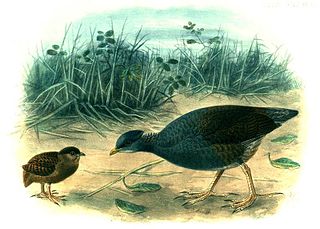
The Tongan megapode is a species of bird in the megapode family, Megapodiidae, currently endemic to Tonga. The species is also known as the Polynesian megapode, and as the Niuafo'ou megapode after the island of Niuafo'ou to which it was restricted for many years. The specific epithet honours British consul William Thomas Pritchard.
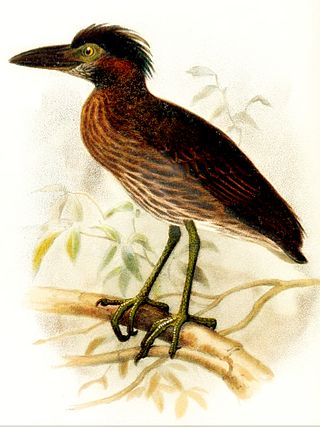
The Bermuda night heron is an extinct heron species from Bermuda.
Trevor Henry Worthy is an Australia-based paleozoologist from New Zealand, known for his research on moa and other extinct vertebrates.
The Niue rail is an extinct species of flightless bird in the Rallidae, or rail family.
Megavitiornis altirostris is an extinct, flightless, giant stem-galliform bird that was endemic to Fiji, it is the only known species in the genus Megavitiornis. Originally thought to be a megapode, more recent morphological studies indicate a close relationship with Sylviornis of New Caledonia, with both genera belonging to the family Sylviornithidae outside of the Galliformes crown group. It is likely that it became extinct through overhunting shortly after the colonisation of the Fiji Islands by humans.
Matuku otagoense, also referred to as the Saint Bathans heron, is an extinct genus and species of heron from the Early Miocene of New Zealand. It was described from fossil material collected in 2007 from the Saint Bathans Fauna of the Bannockburn Formation in Otago, South Island. It was a contemporary of the much smaller Saint Bathans bittern, remains of which have been found in the same sediments. The genus name matuku is a Māori-language word meaning “heron” or "bittern". The specific epithet is a latinisation of the name of the Otago region where the descriptive material was collected.

The St Bathans fauna is found in the lower Bannockburn Formation of the Manuherikia Group of Central Otago, in the South Island of New Zealand. It comprises a suite of fossilised prehistoric animals from the late Early Miocene (Altonian) period, with an age range of 19–16 million years ago.
Manuherikia is a genus of extinct species of ducks from the Miocene of New Zealand. It was described from fossil material of the Saint Bathans Fauna, in the lower Bannockburn Formation of the Manuherikia Group, found by the Manuherikia River in the Central Otago region of the South Island. The genus name comes from the name of the geological formation in which the fossils were found and, ultimately, from the Manuherikia River and its valley.
Miotadorna is a genus of extinct tadornine ducks from the Miocene of New Zealand. It contains two species, M. sanctibathansi, and M. catrionae.












